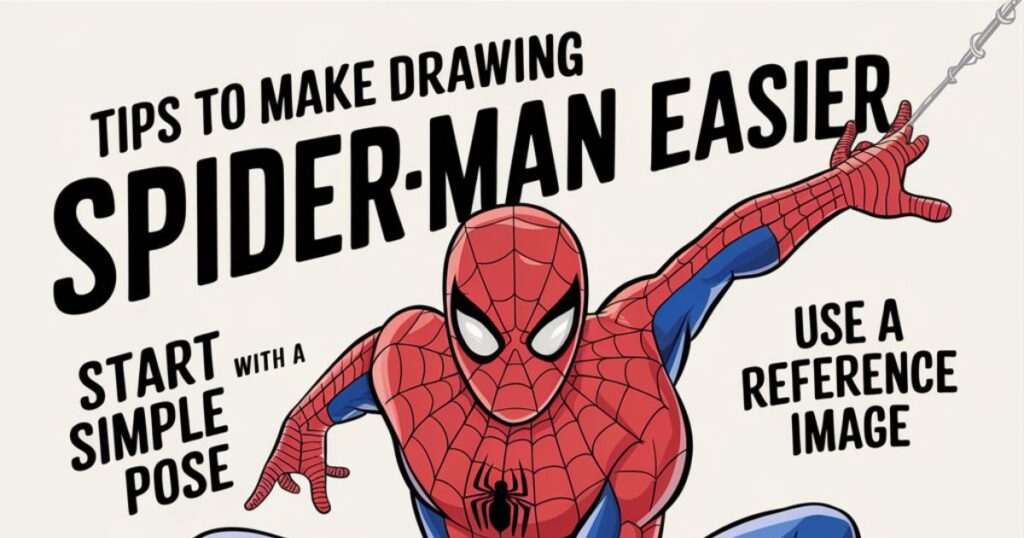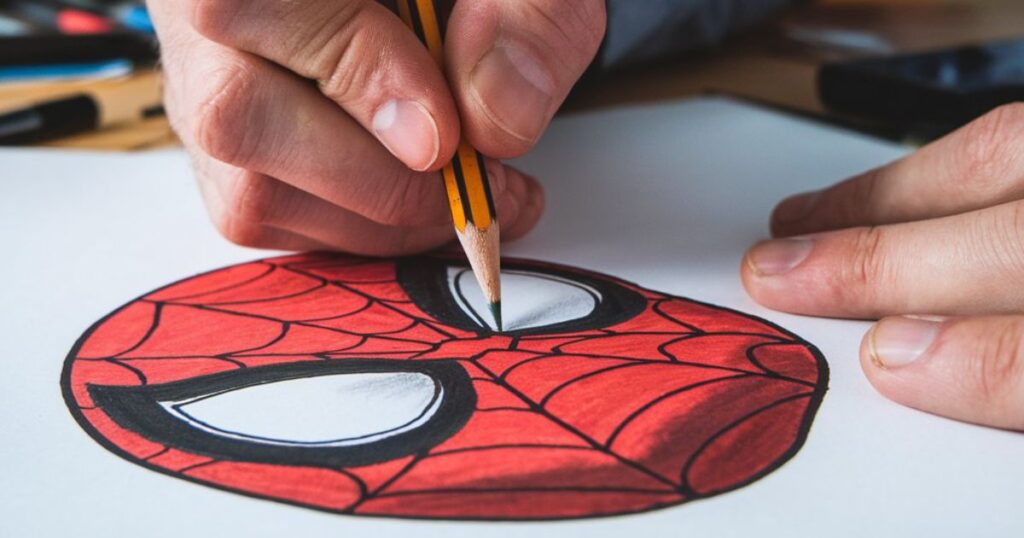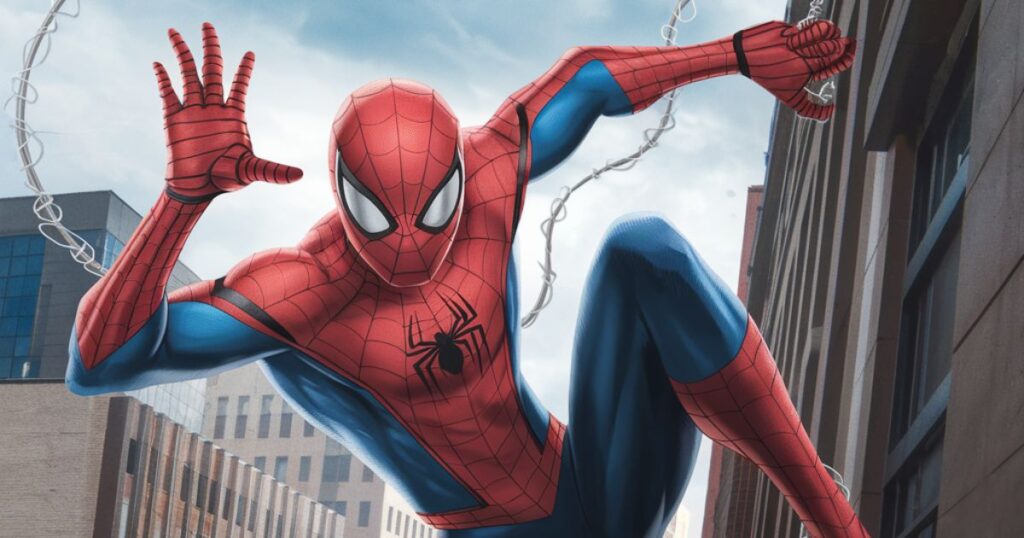Creating a compelling rendition of Marvel’s beloved web-slinger requires more than just artistic talent – it demands an understanding of what makes Spiderman truly extraordinary. This comprehensive guide will transform your artistic journey, whether you’re picking up a pencil for the first time or fine-tuning your superhero sketching skills.
Why Is Drawing Spiderman So Challenging?
The complexity of drawing Spiderman stems from multiple technical and artistic challenges that even seasoned artists find demanding. His iconic suit, with its intricate web pattern, requires meticulous attention to detail and unwavering patience.
The challenge intensifies when capturing his athletic physique while maintaining anatomical accuracy – a balance that many artists struggle to perfect.
The mask itself presents a unique artistic puzzle, as those distinctive eyes must convey a full range of emotions without the benefit of traditional facial expressions. This forces artists to master subtle nuances in the mask’s shape and positioning to communicate everything from determination to humor.
Moreover, Spiderman’s signature poses defy conventional anatomical positioning. His acrobatic movements and impossible angles challenge our understanding of human flexibility and motion, making each drawing session an exercise in creative problem-solving and artistic interpretation.
Tips to Make Drawing Spiderman Easier

Success in drawing Spiderman begins with understanding fundamental artistic principles. Rather than attempting to capture every detail at once, break down your approach into manageable stages. Consider the character’s form as a collection of simple geometric shapes: the head starts as an oval, the torso as a modified rectangle, and limbs as cylindrical forms.
Mastering the suit’s details requires patience and systematic approach. The iconic web pattern follows specific rules – it’s not random decoration but a carefully planned design that responds to movement and form. When drawing these patterns, remember they follow the contours of muscles and create natural flow lines that enhance the dynamic nature of your artwork.
Advanced artists often develop shortcuts and techniques for consistent webbing, but beginners should focus on understanding the basic pattern structure before attempting more complex variations. The web lines typically intersect at regular intervals, creating a diamond pattern that becomes second nature with practice.
Also Read: The Truth About www.iamrestaurant.com Norstrat Restaurant: A Critical Analysis
What Tools Should You Use to Draw Spiderman?
Your artistic arsenal should evolve with your skill level. Beginning artists need only basic supplies, but as your expertise grows, so might your collection of tools. High-quality pencils remain the foundation of any artist’s toolkit, with different grades serving various purposes.
Softer leads (2B-6B) create bold, dark lines perfect for dramatic shading, while harder leads (2H-4H) excel at preliminary sketching and fine details.
The choice of paper significantly impacts your final result. Smooth, heavyweight paper withstands multiple erasures and provides an ideal surface for detailed work. Fine-tip pens prove invaluable for adding crisp webbing details, while colored pencils and markers can bring your finished piece to life with Spiderman’s classic color scheme.
Digital artists might prefer working with digital tablets, which offer unlimited undo options and layers for experimentation. However, traditional media provides tactile feedback that many artists find irreplaceable in their creative process.
Real-Life Example: How I Learned to Draw Spiderman

My journey to mastering Spiderman illustrations began with countless hours of study and practice. Initially, I struggled with proportions and costume details, often producing drawings that looked stiff or anatomically incorrect. The breakthrough came when I started treating each element of the character separately before attempting complete compositions.
I spent weeks studying reference images from various sources – comic books, movies, and even action figures. This comprehensive approach helped me understand how different artists interpreted the character while maintaining his core design elements.
The most valuable lesson came from realizing that even professional artists approach the character differently, giving me the confidence to develop my own style while respecting the fundamental aspects of his design.
Common Questions About Drawing:cuyvl6drpxk= spiderman
Creating convincing dynamic poses requires understanding the principles of motion and weight distribution. Professional artists often begin with strong action lines that capture the energy of the movement before adding anatomical details. This approach ensures your Spiderman appears to be in motion rather than frozen in space.
The key to accurate proportions lies in using the head size as a measuring unit and maintaining consistency throughout your drawing. A professional-looking Spiderman should be approximately 7.5-8 heads tall, with elongated limbs that suggest athletic ability without appearing unrealistic.
How do I make Spiderman’s poses look dynamic?

Creating dynamic poses starts with understanding the flow of movement. Use curved, flowing lines to suggest motion, and exaggerate key poses slightly to enhance drama. Study real athletes and dancers to understand how the human body moves through space.
How do I get the proportions right?
Start with a mannequin shape and use the head size as a measuring unit. Spiderman’s body should be about 7.5-8 heads tall. Pay special attention to his limbs, which should be long and athletic without appearing unrealistic.
What’s the best way to draw the webbing on Spiderman’s suit?
The web pattern follows a specific grid-like structure. Begin with major lines that follow the body’s contours, then add crossing lines to create the signature diamond pattern. Use curves to show how the webbing wraps around his form.
FAQ’s
How do I achieve realistic shading on the suit?
Layer your shadows and highlights gradually, remembering that the suit has both matte and slightly reflective qualities.
Should I start with black and white or color?
Begin in grayscale to master form and shading, then progress to his classic red and blue costume.
How long should I practice before attempting complex poses?
Start with simple standing poses and gradually increase complexity as your confidence grows.
Final Thoughts
Success in drawing Spiderman comes from consistent practice and patient observation. Focus on understanding the fundamentals before tackling complex action scenes. Remember that every artist’s journey is unique, and your interpretation of the character can bring something fresh to this beloved superhero’s legacy.
“With great power comes great responsibility” – This applies to artistry as much as it does to being a superhero. Take your time, practice regularly, and watch your skills develop.
Remember, whether you’re sketching for fun or pursuing professional artwork, the joy of creating your own Spiderman masterpiece makes every challenging moment worthwhile.
Explore the latest news and insights from Echozynth and beyond at Echozynth.com

Kiara Arushi is the dedicated admin of this personal website, which serves as a comprehensive hub for general information across various topics. With a keen eye for detail and a passion for knowledge sharing, Kiara curates content that is both informative and engaging, catering to a diverse audience.
Her commitment to providing accurate and up-to-date information ensures that visitors find valuable insights and practical tips in every post. Whether you’re seeking the latest trends or timeless advice, Kiara’s expertise makes this site a trusted resource for all.

